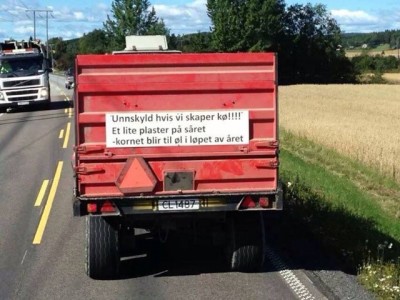An estimated 2,500 farmers flocked to Oslo on Tuesday morning to protest the government’s refusal to give in to their subsidy demands. Many planned to slowly drive their tractors into the city during the morning commute, while one organization would not rule out dumping loads of manure outside parliament.

The tractors traveling into Oslo could not even reach speeds of 40 kilometres per hour, reported Norwegian Broadcasting (NRK). Farmers denied their goal was to disrupt the morning commuter rush-hour traffic, and police were hopeful the action wouldn’t further hinder the already slow-moving morning traffic throughout the day. “There is no point for us in crippling the whole of Oslo, so there won’t be as many tractors as many wanted to have,” said Nils T Bjørke, leader of the Norwegian Farmers’ Union (Norges Bondelag). “But it’s going to make a mark on the main approach roads.”
Farmers were told to gather at the police station in eastern Oslo, then they and their supports planned to march behind the tractor train, through the main streets into the city centre. Unions said there would be a protest outside Parliament from around 1pm, giving angry farmers and their supporters the chance to speak out against the Agricultural and Food Minister, the Progress Party’s Sylvi Listhaug.
“Then she will get to explain to the farmers what she believes is so great about the government’s offer,” Bjørke told news bureau NTB.
While Bjørke promised the protest would unfold in a “seemly” manner, other organizations did not rule out resorting to dirty measures. “If there is going to be a load of dung outside Parliament or not, you will get to see tomorrow,” Ann Merete Furuberg from the Farmers and Smallholders League (Norsk bonde og småbrukarlag) told NRK on Monday night.
Expand or close – the only options?
Marit Epletveit runs a small farm with 30 cows outside Ålgård in Rogaland county. She told NRK she was joining the protests because the government’s agricultural settlement offer will force her to either expand, or close down. “If we invest, we will have problems keeping the fields in good condition,” she said. “In addition it will impact on the cows’ quality of life.”
The head of the Rogaland farmers’ organization, Ola Andreas Byrkjedal, said there had been a lot of interest from farmers wanting to mobilize and head east to the Oslo protests. The union branch gathered enough money for 100 farmers to make the journey, but the total number was closer to 200. “People are practically forming a queue to go along and highlight their grievances,” he said.
New Zealand farmers shaking their heads
On Sunday, NRK contrasted the situation in Norway with farming in New Zealand on the other side of the world. The two countries share similar welfare-based democratic systems, a comparable population, and landscape characterized by high mountains, deep fjords, and heavy snows in winter. New Zealand agricultural produce is considered among the world’s best, but since the government was on the brink of bankruptcy in the 1980s the farmers have not received one single dollar in government subsidies.
“The farmers are very adaptive and resilient,” said Conor English, the leader of Federated Farmers. “You will not find a single farmer in New Zealand who wants to return to subsidized agriculture. The farmers here in the country are the world’s best.” English said they had to be, in order to compete on the open market.
Sheep farmer Drew Dundas said farming subsidies create a false economy, and the money should instead be spent on education and health. Sheep and cattle farmer Anders Crofoot said he had been to Norway, and was surprised by the huge tractors and machinery fleets every farmer seemed to have. “It struck me that it must be much more profitable if they had a couple of contractors, instead of every landholder having their own machinery.”
Pressuring Parliament
The Norwegian farmers’ unions accused the government of making an unfair offer and showing an unwillingness to negotiate in this year’s agricultural agreement. Negotiations broke down earlier this month after farmers requested an extra NOK 1.5 billion (USD 252 million) in state support through direct subsidies, price setting, other regulatory measures and protectionist policies. The government countered with an extra NOK 150 million on top of the NOK 13 billion it already gives farmers, equating to an average 3.5 percent pay rise which is in line with other sectors.
Farmers immediately began protest action, including tractor convoys and last week’s blockade of egg processors. Bjørke argued there was no majority support behind the government’s offer, and said the action was designed to force the parliament to take action. “Therefore we hope that the parliamentary majority now takes steps to force the government back to the negotiating table,” he said. “But so far, the government has not had anything to come with.”
Listhaug’s offer is expected to be considered by Parliament on Friday, ahead of an open hearing by the industry committee next Tuesday. Farmers said Parliament should reject the offer, and require it to be negotiated further with clearer guidelines. Others have commented that the offer is no worse, and in some instances better, than settlements farmers have accepted in recent years.
newsinenglish.no/Emily Woodgate

